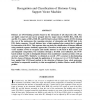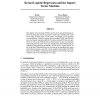127
Voted
ICDM
2009
IEEE
14 years 10 months ago
2009
IEEE
There has been significant recent interest in sparse metric learning (SML) in which we simultaneously learn both a good distance metric and a low-dimensional representation. Unfor...
99
Voted
ICPR
2010
IEEE
14 years 10 months ago
2010
IEEE
In this paper, we propose a novel approach for identity verification based on the directional analysis of velocity-based partitions of an on-line signature. First, interfeature dep...
121
click to vote
PR
2010
14 years 11 months ago
2010
Selecting relevant features for Support Vector Machine (SVM) classifiers is important for a variety of reasons such as generalization performance, computational efficiency, and ...
105
click to vote
IJON
2010
14 years 11 months ago
2010
Radiation-induced lung injury, radiation pneumonitis (RP), is a potentially fatal side-effect of thoracic radiation therapy. In this work, using an ensemble of support vector mac...
126
click to vote
TNN
2008
15 years 14 days ago
2008
Abstract--Large-margin methods, such as support vector machines (SVMs), have been very successful in classification problems. Recently, maximum margin discriminant analysis (MMDA) ...
116
click to vote
JMLR
2006
15 years 15 days ago
2006
Support vector machines utilizing the 1-norm, typically set up as linear programs (Mangasarian, 2000; Bradley and Mangasarian, 1998), are formulated here as a completely unconstra...
JCB
2006
15 years 16 days ago
2006
Histones are DNA-binding proteins found in the chromatin of all eukaryotic cells. They are highly conserved and can be grouped into five major classes: H1/H5, H2A, H2B, H3, and H4...
103
click to vote
UAI
2000
15 years 1 months ago
2000
The Support Vector Machine (SVM) of Vapnik [9] has become widely established as one of the leading approaches to pattern recognition and machine learning. It expresses predictions...
136
Voted
NIPS
2001
15 years 1 months ago
2001
The support vector machine (SVM) is known for its good performance in binary classification, but its extension to multi-class classification is still an on-going research issue. I...
140
Voted
DAGM
2004
Springer
15 years 4 months ago
2004
Springer
Abstract. In this paper, we present a novel method for reducing the computational complexity of a Support Vector Machine (SVM) classifier without significant loss of accuracy. We a...








